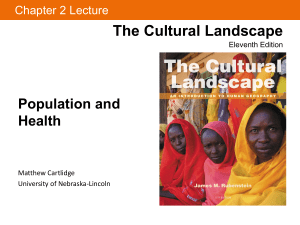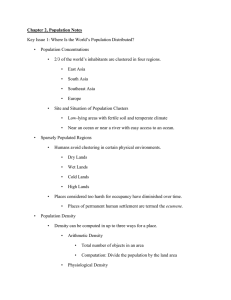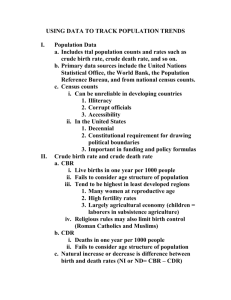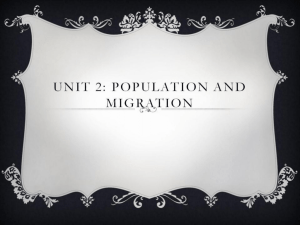Unit 2 Population MCQs (Part 1)
advertisement
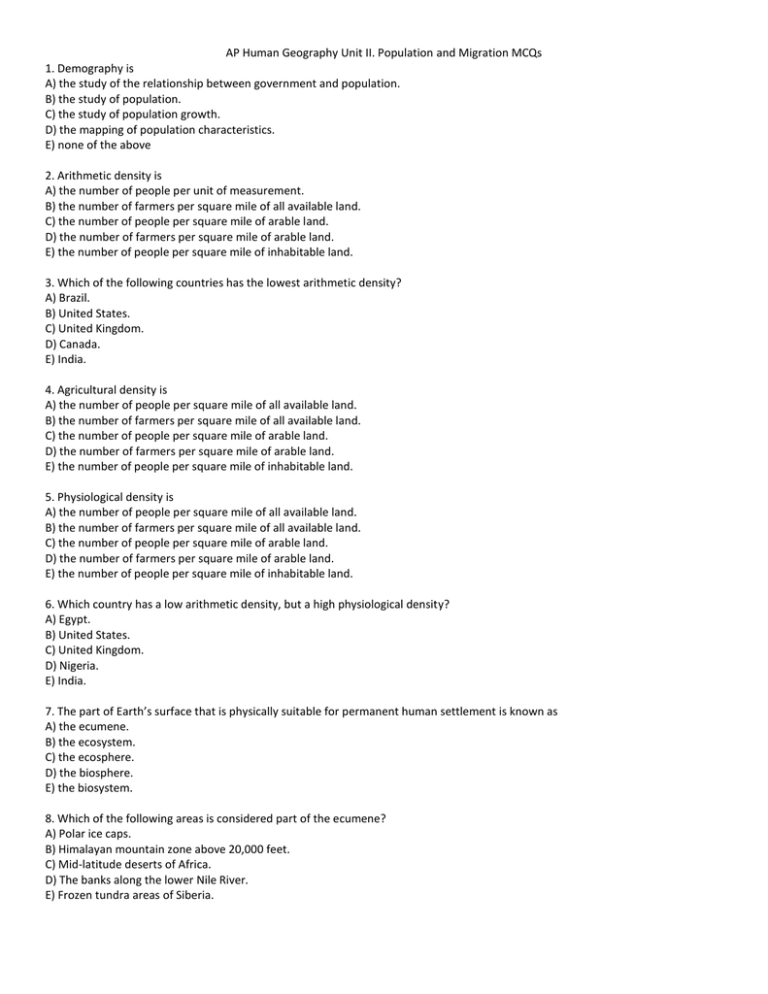
AP Human Geography Unit II. Population and Migration MCQs 1. Demography is A) the study of the relationship between government and population. B) the study of population. C) the study of population growth. D) the mapping of population characteristics. E) none of the above 2. Arithmetic density is A) the number of people per unit of measurement. B) the number of farmers per square mile of all available land. C) the number of people per square mile of arable land. D) the number of farmers per square mile of arable land. E) the number of people per square mile of inhabitable land. 3. Which of the following countries has the lowest arithmetic density? A) Brazil. B) United States. C) United Kingdom. D) Canada. E) India. 4. Agricultural density is A) the number of people per square mile of all available land. B) the number of farmers per square mile of all available land. C) the number of people per square mile of arable land. D) the number of farmers per square mile of arable land. E) the number of people per square mile of inhabitable land. 5. Physiological density is A) the number of people per square mile of all available land. B) the number of farmers per square mile of all available land. C) the number of people per square mile of arable land. D) the number of farmers per square mile of arable land. E) the number of people per square mile of inhabitable land. 6. Which country has a low arithmetic density, but a high physiological density? A) Egypt. B) United States. C) United Kingdom. D) Nigeria. E) India. 7. The part of Earth’s surface that is physically suitable for permanent human settlement is known as A) the ecumene. B) the ecosystem. C) the ecosphere. D) the biosphere. E) the biosystem. 8. Which of the following areas is considered part of the ecumene? A) Polar ice caps. B) Himalayan mountain zone above 20,000 feet. C) Mid-latitude deserts of Africa. D) The banks along the lower Nile River. E) Frozen tundra areas of Siberia. 9. Globally, the three largest population concentrations are located in A) Southeast Asia, West Africa, and East Asia. B) East Asia, West Africa, and Europe. C) East Asia, Southeast Asia, and South Asia. D) Europe, South Asia, and East Asia. E) Europe, North America, and East Asia. 10. The four major population clusters in the world include all of the following regions except A) South America. B) South Asia. C) East Asia. D) Southeast Asia. E) Europe. 11. The population clusters in Asia A) are the three most populated clusters in the world. B) are all highly urbanized. C) are predominately rural in nature. D) are dominated by the secondary sector of the economy. E) none of the above 12. Reasons why women in the United States are having fewer children than 50 years ago include all of the following except A) women are getting married later in life. B) women are becoming more educated. C) women are more likely to enter the work-force. D) women have poorer diets. E) women are more likely to use contraceptives. 13. Problems associated with fast population growth in cities include A) an increase in air and water pollution. B) the loss of productive farmland near cities. C) an increase in traffic congestion. D) urban slums which result in more poverty and crime. E) all of the above. 14. All of the following are population clusters in the East Asian population concentration except A) eastern China. B) the Korean Peninsula. C) Japan. D) western China. E) Taiwan. 15. Since 1950, this part of the developing world has seen a dramatic increase in population. A) Urban areas. B) Rural areas. C) Non-industrial areas. D) Areas away from coasts. E) Agricultural areas. 16. What region of North America is most densely populated? A) West Coast. B) Northeast. C) Pacific Northwest. D) Upper Midwest. E) Southeast. 17. Which U.S. state has the highest Natural Increase Rate (NIR)? A) Texas. B) Utah. C) California. D) Colorado. E) New Mexico. 18. Which of the following states has the lowest population growth rate? A) California. B) Texas. C) Nevada. D) New York. E) Georgia. 19. The two regions of the United States with the slowest population growth are A) East Coast and Midwest. B) Northeast and South. C) Midwest and West. D) West and South. E) East Coast and Southeast. 20. Humans do not populate in large numbers A) areas that are too wet. B) areas that are too cold. C) areas that are too dry. D) areas that are too high in elevation. E) all of the above. 21. Highland areas support large populations in A) Central Mexico. B) East Africa. C) Central Asia. D) Southeast Asia. E) A and B only. 22. The largest major population concentration of North America is A) from Miami to Jacksonville. B) from San Diego to San Francisco. C) from Washington D.C. to Boston. D) from Toronto to Montreal. E) none of the above. 23. Which statement best describes the different characteristics of population in the United States and Europe? A) Europe has many more wide-open spaces than the United States has. B) The United States has more area than Europe does. C) The arithmetic density of the United States is less than that of Europe. D) Europe’s population density is lower than that of the United States. E) Europe’s population is smaller than that of the United States. 24. Carrying capacity is the A) limit at which population can be sustained through its resources and trade. B) maximum number of people an area can support using the theoretical limits of energy production. C) maximum number of people an area can support using organic agricultural methods and technology. D) maximum number of people an area can support using all of its available resources and technology. E) maximum number of people an area can support using traditional agricultural methods. 25. The theory that farmers will adopt new and modern methods to keep up with demand caused by an increasing population was proposed by A) Thomas Malthus. B) Neo-Malthusians. C) Esther Boserup. D) Ernest Ravenstein. E) Walter Christaller AP Human Geography Unit II. Population Formative Test 2 1. Which statement about overpopulation is true? A) Overpopulation is unlikely because food production potential is unlimited. B) Overpopulation occurs when an area’s population is greater than its carrying capacity. C) Overpopulation can only occur in less-developed areas. D) Overpopulation is achieved when the physiological density reaches more than 1,000/km. E) All of the above. 2. Under what circumstances could high birth rates pose a challenge for a country? A) If a country’s economy grows at a slower rate than the Crude Birth Rate (CBR). B) If a country is unable to provide adequate health care for its citizens. C) If a country’s natural resources are depleted in an unsustainable manner. D) If a country’s population structure resembles a pyramid. E) All of the above. 3. The highest Crude Birth Rates (CBR) in the world are found in A) Latin America. B) Middle East. C) China. D) Sub-Saharan Africa. E) Europe 4. This is the measurement that shows the average number of people in an area’s population who are not economically productive, who must be supported by the area’s economically productive population. A) Employment Ratio. B) Dependency Ratio. C) Industrial Production Ratio. D) Productive Class Ratio. E) Jobless Ratio. 5. All of the following populated areas are on or close to major earthquake fault lines except A) central Mexico. B) Japan. C) western Europe. D) Indonesia. E) California. 6. What differentiates a natural disaster from a natural hazard? A) A natural disaster includes only the loss of life. B) A natural hazard includes only the loss of property. C) A natural disaster often includes the loss of property and life. D) A natural hazard is a predictable event. E) All of the above. 7. Which of the following graphs exhibits a J-curve? A) Global Birth Rates over time. B) Global Infant Mortality Rates over time. C) Global Population Growth over time. D) Global Dependency Ratio rate over time. E) All of the above. 8. Historically, the world’s population grew A) very steadily from 1000 CE until the present. B) slowly until about 1800 CE, before growing quickly between 1800 CE and the present. C) quickly until about 1800 CE, before slowing down between 1800 CE and the present. D) slowly until about 1000 CE, before growing quickly between 1000 CE and the present. E) quickly until about 1000 CE, before declining between 1800 CE and the present. 9. Over the past 200 years, the population of the world A) has increased by approximately more than 5.5 billion. B) has increased by more than 7 billion. C) has increased by about 80 million people per year. D) has slightly decreased from a high of 8 billion to under 7 billion. E) has roughly stayed the same. 10. In the next 50 years, the population of the world A) is expected to level off at slightly more than 12 billion. B) is expected to rise to a high of 13 billion before starting to decline. C) is expected to decline to less than 5 billion people due to lack of food supply. D) is expected to double to over 13 billion people. E) is expected to rise to approximately 9 billion. 11. The total change in population of a country’s population is represented by which of the following equations? A) Total Population Change = Number of Births – Number of Deaths + Number of Immigrants – Number of Emigrants. B) Total Population Change = Number of Births – Number of Deaths + Number of Emigrants – Number of Immigrants. C) Total Population Change = Number of Births + Number of Deaths – Number of Immigrants + Number of Emigrants. D) Total Population Change = Number of Births + Number of Immigrants. E) Total Population Change = Number of Deaths – Number of Emigrants. 12. A country’s Total Fertility Rate is A) the average number of children a woman can expect to give birth to during her lifetime. B) the number of children who are born and survive past their first birthday. C) the average number of children who are born and survive for a week. D) the total number of children born per 1,000 population. E) a theoretical maximum number of children a woman can bear. 13. In order to replace its population only, a country needs a total fertility rate of A) 1.2. B) 2.1. C) 3.0. D) 3.5. E) 4.1. 14. A country’s Crude Birth Rate (CBR) is A) the average number of children a woman can expect to give birth to during her lifetime. B) the number of children who are born and survive past their first birthday. C) the average number of children who are born and survive for a week. D) the total number of children born per 1,000 population. E) a theoretical maximum number of children a woman can bear. 15. The United Kingdom has a higher death rate than Costa Rica. This is due to the fact that A) Costa Rica has a more modern health care system than the United Kingdom. B) Costa Rica’s population is younger than the United Kingdom’s population. C) the United Kingdom has a much higher infant mortality rate than Costa Rica. D) the United Kingdom has many more incidences of industrial accidents than Costa Rica. E) the United Kingdom has a higher cancer rate than Costa Rica. 16. Poland’s total fertility rate is 1.2. What impact will this have on Poland’s population? A) Poland’s population is steadily increasing. B) Poland’s population is quickly increasing. C) Poland has reached zero population growth. D) Poland’s population is decreasing. E) Poland’s population has a doubling time of about 23 years. 17. A country’s Crude Death Rate (CDR) is A) the total number of people who die in any given year. B) the total number of elderly people who die in any given year. C) the total number of children who are born and die within the first year. D) the total number of people who die in a given year, excluding infants. E) the total number of people who die per 1,000 population. 18. Presently, natural increase in population is primarily due to A) an increase in the birth rate. B) an increase in the death rate. C) a decrease in the birth rate. D) a decrease in the death rate. E) an increase in the birth rate combined with a decrease in the death rate. 19. Even after a country’s birth rate and death rate reach a point of zero population growth, the total population will continue to grow for a period of time before it starts to decline. This concept is known as A) demographic momentum. B) natural increase. C) a baby boom. D) an echo boom. E) a population explosion. 20. The Natural Increase Rate (NIR) is calculated by A) adding the Crude Death Rate (CDR) from the Crude Birth Rate (CBR) and dividing by 70. B) subtracting the Crude Death Rate (CDR) from the Crude Birth Rate (CBR) and dividing by 70. C) adding the Crude Death Rate (CDR) to the Crude Birth Rate (CBR). D) subtracting the Crude Birth Rate (CBR) from the Crude Death Rate (CDR). E) subtracting the Crude Death Rate (CDR) from the Crude Birth Rate (CBR). Use these data to answer the following questions 56-58. Country A Crude birth rate 38 per 1000 people Crude death rate 18 per 1000 people 21. The Natural Increase Rate (NIR) of Country A is A) 56 per 1000. B) 2%. C) 20%. D) half the rate of Country B. E) about the same rate as Country B. 22. From the data, one might conclude that Country B A) is in Stage 1 of the Demographic Transition Model (DTM). B) has achieved zero population growth. C) has a negative rate of natural increase. D) is a less developed country. E) is a more developed country. 23. From the data, it is apparent that A) the population of Country A will double in 35 years. B) the population of Country B will double in 15 years. C) the carrying capacity of Country A is being strained. D) Country A has a larger population than Country B. E) Country A is overpopulated. Country B Crude birth rate 18 per 1000 people Crude death rate 9 per 1000 people 24. The Natural Increase Rate (NIR) measures A) the rate of population growth in an area as measured by its birth rate and death rate. B) the rate of population growth in an area as measured by its birth rate, death rate, and immigration rate. C) the rate of population growth in an area as measured by its birth rate and immigration rate. D) the rate of population growth in an area as measured by its birth rate, death rate, and emigration rate. E) the rate of population growth in an area as measured by its birth rate, death rate, immigration rate, and emigration rate. 25. The Total Fertility Rate of the United States for 2008 was estimated to be 2.1. What does this mean for the population of the United States? A) The doubling time of the United States is about 35 years. B) The United States is experiencing rapid natural increase. C) All population growth in the United States is due to migration and not natural increase. D) The United States will experience population decline in the next 30 years. E) All of the above. AP Human Geography Unit II. Population Formative Test 3 1. At the current growth rate, the doubling time of the world’s population is approximately A) 14 years. B) 26 years. C) 38 years. D) 54 years. E) 80 years 2. Which statement about the Male-Female Sex Ratio is most accurate? A) More males are born than females, but females outnumber males after age 80. B) More females are born than males, but males outnumber females after age 80. C) Males outnumber females at all ages. D) Females outnumber males at all ages. E) Males and females are equal in number at all ages. 3. The major factor contributing to the explosive population growth in More Developed Countries (MDCs) during the 19th and early 20th centuries was A) the diffusion of the Industrial Revolution. B) the diffusion of modern medical practices C) the diffusion of vaccines and antibiotics. D) the diffusion of family planning programs. E) the diffusion of birth control devices. 4. What effect did the diffusion of modern medical practices and drugs have on the global population? A) Healthier diets for women increased the total fertility rate around the world. B) Population increased because many formerly fatal diseases were cured. C) The world experienced lower death rates due to an increased emphasis on sanitation. D) A and B only. E) B and C only. 5. The major reason for high growth rates in Least Developed Countries (LDCs) is A) most people in Least Developed Countries (LDCs) do not have access to birth control. B) the total fertility rate in Least Developed Countries (LDCs) is nearing 7 children born per woman. C) people in Least Developed Countries (LDCs) have lower incidence of fatal diseases than people in More Developed Countries (MDCs). D) the birth rate in Least Developed Countries (LDCs) has increased dramatically over the past 50 years. E) advanced medical practices and drugs have dramatically reduced death rates in Least Developed Countries (LDCs). 6. Presently, most population growth in the world is occurring A) in Western countries. B) in More Developed Countries (MDCs). C) in Least Developed Countries (LDCs). D) in Africa. E) in the Western Hemisphere. 7. Thomas Malthus believed that A) the government should encourage population growth in order to fully staff the factories being built during the Industrial Age. B) the world would soon be overpopulated because population grows at an exponential rate while the food supply increases at an arithmetic rate. C) the world would find new sources of food production to offset population growth. D) population increase will continue because many religions discourage the use of contraceptives. E) all of the above. 8. Neo-Malthusian theory believes that A) in addition to outstripping food supply, world population growth is also overtaxing other resources like fuel and energy. B) governments should discourage population growth because industrial growth is slowing in the developed countries. C) population growth in Least Developed Countries (LCDs) will end as the population in those countries becomes more educated. D) More Developed Countries (MDCs) will experience a population crash due to the aging of their populations. E) none of the above. 9. According to Thomas Malthus, natural “checks” on a population include all of the following except A) disease. B) famine. C) war. D) natural disasters. E) agricultural advancements. 10. Life expectancy is A) the average number of years a person will live at birth. B) the number of years a person will live. C) the average number of years a person will live according to their genetic makeup. D) the number of years a person could theoretically live. E) the average number of years a person is expected to live. 11. Which of the following factors does not affect a person’s life expectancy? A) Gender/sex. B) Socio-economic status. C) Education. D) Parents’ ages at the time of the person’s birth. E) Access to health care. 12. Which person is most likely to live to be 100 years old? A) A newborn male. B) A 16-year-old female. C) A 45-year-old male. D) A 54-year old female. E) A 91 year-old male. 13. Reasons why life expectancy in Africa is so low include all of the following except A) the diffusion of AIDS. B) poor sanitation. C) famine. D) the spread of SARS. E) frequent fighting and war. 14. Why was the Demographic Transition Model based on England’s experience? A) The church kept excellent birth and death records from the year 1000 CE. B) England experienced less migration than most other countries in Europe. C) England’s territory has changed little. D) England was the first country to pass through all stages of the model. E) All of the above. 15. How can a country or region slow down its birth rates? A) Keep girls in school longer. B) Improve the quality of life for its citizens. C) Distribute birth control devices. D) Fund family planning programs. E) All of the above. 16. An anti-natalist population policy A) is meant to lower the infant mortality rate. B) is meant to raise the Total Fertility Rate (TFR) of the population. C) is meant to lower the Total Fertility Rate (TFR) of the population. D) encourages population growth. E) discourages the use of birth control. 17. An example of an anti-natalist population program is A) China’s One Child Policy. B) Singapore’s Population and Family Planning Board. C) India’s sterilization programs. D) Iran’s programs to encourage small families. E) All of the above. 18. Reasons why governments promote anti-natalist population policies include A) controlling the high population growth of a country. B) preserving the culture of the country. C) efforts to make women second-class citizens. D) efforts to stimulate the economy of the area. E) all of the above. 19. Which country’s government is most likely to promote an anti-natalist population policy? A) United Kingdom. B) China. C) France. D) Russia. E) Australia. 20. Pro-natalism is A) a governmental policy that discourages its population to have more children. B) a government policy that encourages its population to have more children. C) a government policy that encourages growth through migration. D) a government policy that encourages zero population growth. E) none of the above 21. An example of a pro-natalist population program is A) a program that gives women a monetary stipend for having three or more children. B) a law that allows families to receive tax breaks for dependent children. C) a law that establishes free and reduced day care for all families. D) a law that requires businesses to give women generous maternity leave policies. E) all of the above. 22. Reasons the government would create pro-natalist population policies include A) preserving their country’s culture. B) lowering the dependency ratio of the country. C) insuring that the country has an adequate future workforce. D) all of the above. E) A and B only. 23. Which country’s government is most likely to promote a pro-natalist population policy? A) United Kingdom. B) China. C) France. D) India. E) Nigeria. 24. The phenomenon when a country experiences a decline in the total fertility rate so that it experiences no natural increase is known as A) Zero Population Growth. B) Demographic Balance. C) Natural Increase Neutrality. D) Population Stagnation Point. E) none of the above. 25. What is an excellent way to bring down a country’s population growth rate without increased funding for family planning and distribution of birth control devices? A) Improve the economic environment. B) Improve the health care system. C) Decrease military expenditures. D) Increase funding for early childhood education. E) All of the above.
